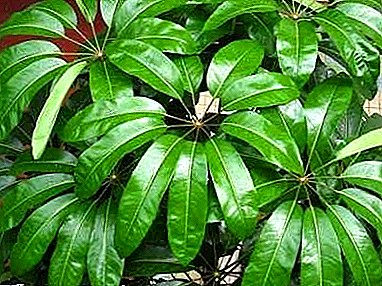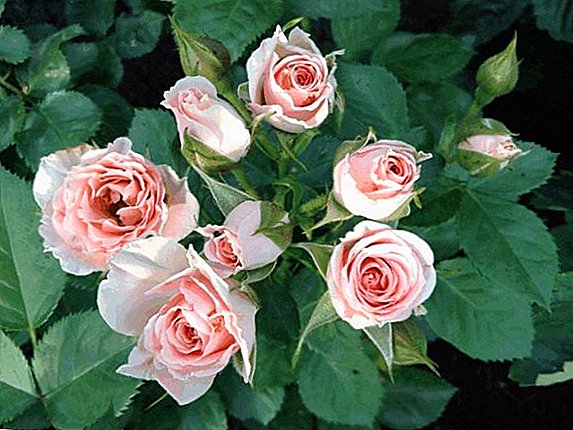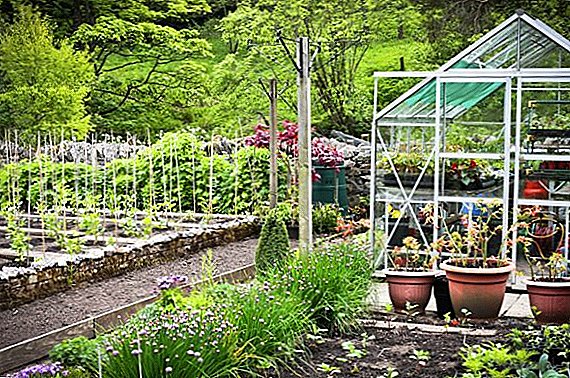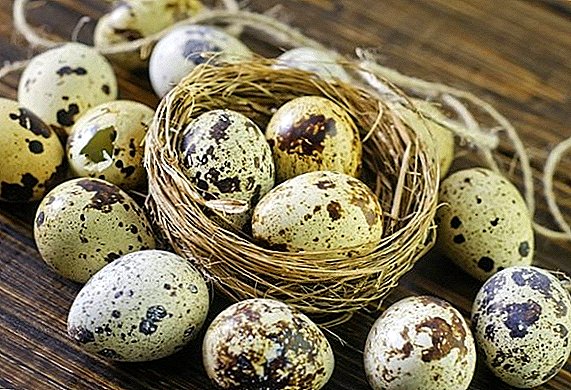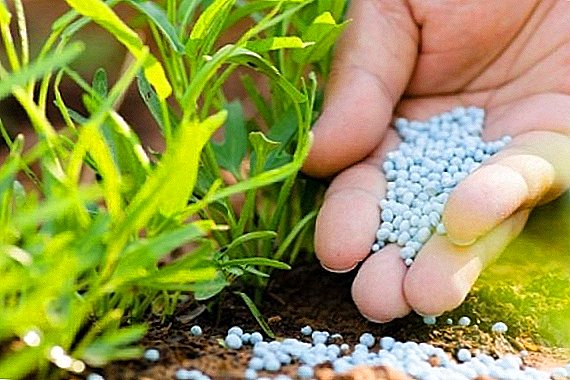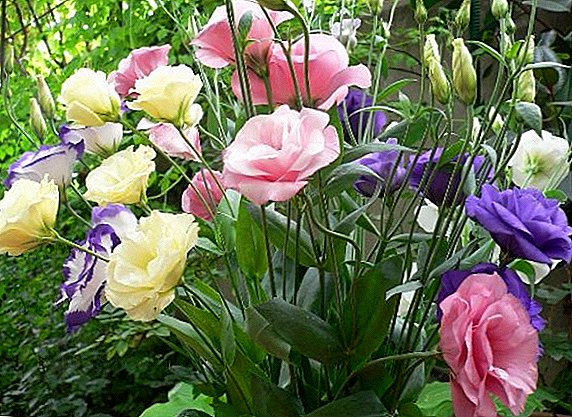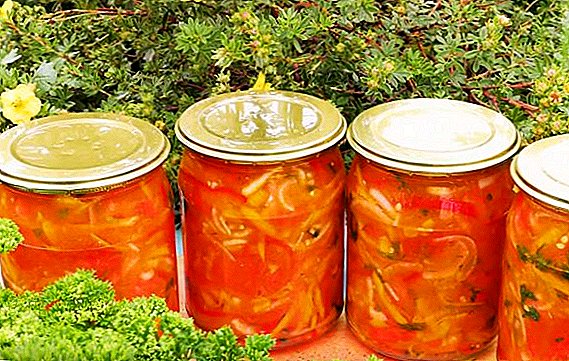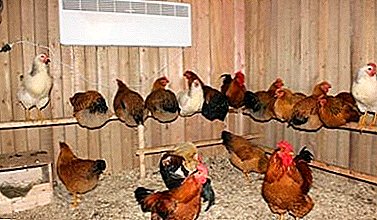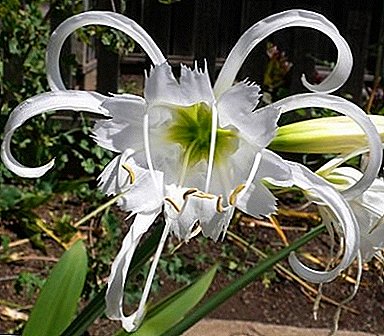
"Gimenokallis" - a thermophilic flowering plant. Excellent response to fertilizing, systematic watering, good lighting.
Can tolerate direct sunlight. Propagated by seeds and daughters.
It actively grows at temperatures above 20 ° C.
Plant description
"Gimenokallis" has about 50 different subspecies. It belongs to the family Amaryllidaceae. Growing area - South America. Latin name: Hymenocallis.
Reference! Bulbs are used as planting material.
They have a pear-shaped and bright dry scales. As they grow in diameter, they reach 10-12 cm. The leaves grow in one plane. In length reach from 60 to 110 cm. In many subspecies the sheet plate is pronounced. It has a shape in the form of a belt and a dented central vein.
Vein endowed with an elongated sharp tip. The surface is glossy, emerald. Other subspecies are evergreen, and still others drop leaflets during the rest period.
A photo
The photo shows the flowers of "Hymenocallis" in the open ground:





Home care
Bloom
 All subspecies are endowed with an unusual form of flowers. Have the form in the form of an asterisk or a spider. The flower has a calyx and 6 petals. In length, they reach more than 20 cm.
All subspecies are endowed with an unusual form of flowers. Have the form in the form of an asterisk or a spider. The flower has a calyx and 6 petals. In length, they reach more than 20 cm.
They have narrowed sepals, emerald at the base. Some subspecies have curved petals, other subspecies are endowed with drooping petals.
Corolla of 6 petals. According to the form, it is sreen-like, radial. The fused stamens have a shape in the form of a funnel, with a depth of no more than 6 cm. Stamens are half the size of the sepals.
Anthers are large, amber, egg-shaped. Flowers are very fragrant. Collected in inflorescences in the form of umbrellas for 2-16 pieces in each. Inflorescences have 2-3 bracts.
Peduncle of the same length as the leaves. It has a flattened section and a bare stem. After flowering, the plant forms a fleshy, egg-shaped fruit. They contain large seeds that can be used for planting.
In this video, we will see how Hymenocallis is dissolved:
Watering
Watering should be systematic and very careful. The plant must create conditions similar to natural. It is impossible to allow overmoistening of the earth, and also strong drying.
Attention! Excessive watering leads to waterlogging of the soil and rotting of the root system.
In this case, the humidity provokes the dying off of the ground top. After that, you will have to wait for the new season when Himenokallis wakes up after a period of rest. Strong drying results in dropping of buds and loss of turgor. The plant may stop blooming. Therefore, you should choose a systematic watering, in which the soil should remain slightly wet all the time.
During the rest period, watering is reduced to a minimum. If during this period the flower dropped the leaves completely, then it can go without watering for more than 2 weeks. Water should be without any chemical impurities. It is best to use boiled, separated, rain or melt water.
Landing
 Lightweight, breathable soils are best for planting. The earth should be rich in vitamins, organic ingredients and trace elements.
Lightweight, breathable soils are best for planting. The earth should be rich in vitamins, organic ingredients and trace elements.
It is preferable to contain a flower in a weakly acidic soil in the range of 5.7-6.6 pH.
In such conditions, the plant blooms more brightly and scaled. For this purpose, turf and leaf soil, humus, fine-grained sea sand and peat are used. For the prevention of onion rot, charcoal is added to the substrate.
The plant is endowed with a very powerful root system. Therefore it is necessary to choose spacious containers
At the bottom of the stack drainage system. Pebbles, broken bricks or expanded clay prevent stagnation of water. The bulbs are planted in the middle of the tank. It is important that 1/3 of the planting material protrudes above the ground surface.
Attention! It is impossible to sprinkle the bulbs with soil entirely. In this case, the planting material will not be able to germinate, it will not have access to release arrows. Bulbs can rot in the ground.
Transfer
 It is extremely undesirable to touch the root system of a plant, since it tolerates transplantation very poorly. Therefore, experienced growers planted a flower in the tank immediately for permanent growth.
It is extremely undesirable to touch the root system of a plant, since it tolerates transplantation very poorly. Therefore, experienced growers planted a flower in the tank immediately for permanent growth.
Transplantation is carried out only as far as filling the soil with the root system, when filling the roots or too poor soil. The procedure is carried out 1 time in 4 years. When grown in decorative containers, transplantation takes place in the spring.
Temperature
The plant actively grows at temperatures above 20 ° C. In winter, in the absence of artificial lighting, evergreen subspecies need to create the coldest temperature conditions. They are moved closer to the frozen windows, placed under the bath, in the pantry, closet, cellar or veranda.
At this time, “Himenokallis” needs a temperature of 13-19 ° C. Bulbs of planting material in deciduous subspecies are kept in cool rooms with dry air. They need a temperature of 9-13 ° C.
Lighting
The plant is very light-loving. Can tolerate direct sunlight.
Important! With a lack of light, "Gimenokallis" will stop blooming.
In winter, the flower requires additional artificial lighting. It is important that the plant is at the 10-hour daylight level.
Breeding
 This representative of the flora is propagated by seeds and daughter bulbs. Growth occurs only 3-4 years after planting. Sprouts are separated from the maternal planting material and planted in separate containers.
This representative of the flora is propagated by seeds and daughter bulbs. Growth occurs only 3-4 years after planting. Sprouts are separated from the maternal planting material and planted in separate containers.
During the period of active growth, it is necessary to carefully monitor the water level in the soil, top dressing. Do not allow drafts and direct cold wind.
Fertilizer
During flowering and active growth, the flower is fertilized 1 time in 14-21 days. To do this, use liquid fertilizer for flowering domestic or bulbous plants. Concentration of the drug follow strict instructions.
Attention! Do not fertilize "Hymenocallis" with nitrogen-containing preparations. Such mixtures inhibit the growth of flower buds and increase the growth of emerald leaves.
If there is an excess of fertilizer, the plant will stop flowering. Also, nitrogen-containing fertilizers can provoke the appearance of gray mold on the bulb. During the rest period, it is forbidden to feed the plant.
Pests
Aphids, spider mites and thrips can affect this flora. The affected areas must be removed. Then the plant is washed under a stream of warm water, having previously closed the root system with cellophane. After the shower, the flower is rubbed with cotton wool and soapy water. You can use household and tar soap. If after folk remedies the pests have not disappeared - “Gimenokallis” is treated with insecticides. Perfect fitoverm or Aktellik.
Diseases
 The most common and dangerous disease is gray bulb onion. Since the bulb is the heart of the plant, its defeat leads to death.
The most common and dangerous disease is gray bulb onion. Since the bulb is the heart of the plant, its defeat leads to death.
When transplants are always necessary to carefully examine the root system of the flower. If there are defects or sore spots, they are carefully cut with a special knife.
Wounds on the cut must be powdered with charcoal. The cause of this disease is waterlogging.
Important! The most dangerous period of the disease is the cold season.
Also inexperienced growers face various difficulties. The biggest trouble is not the flowering of the plant. The reason may be a lack of sunlight, fertilizer, fertilizing, poor soil or improper wintering with too high temperatures.
"Gimenokallis" - flowering perennial plant. In winter, requires a period of rest and lowering the temperature in the room. With poor care it can be affected by pests. Loves bright natural light, liquid fertilizer and careful watering. Excellent response to additional lighting, spraying water from the sprayer and gentle care.



